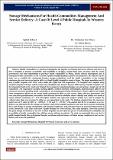| dc.description.abstract | Health commodities are stored and managed at the hospital warehouses and service delivery unit stores in level 4 hospitals to promote accessibility and availability at all times. Despite huge sums of money spent by county governments and other stakeholders to purchase health commodities in Kenya, service delivery interruptions due to inadequate health commodities is still recorded in public hospitals leading to patients dissatisfaction. The objective of this study was to establish the relationship between storage mechanisms used for health commodities at the hospital warehouse plus unit stores and service delivery at level 4 public hospitals in western Kenya. The target population was 99 level 4 public hospitals with NHIF codes within the region and 426 respondents. The hospitals were sampled using stratified sampling technique and the sample size calculated using Yamane formula (1967) giving 79 public hospitals. For the respondents both at the county and hospital levels, purposive sampling technique was used giving a sample size of 346 respondents. The respondents included nursing officers, medical laboratory technologists, pharmaceutical officers and warehouse personnel handling health commodities at the hospitals plus health administrators, finance officers and supply chain management officers at the county health management office in each county. Data collection instruments used were structured questionnaires, observation checklists and interview schedules whose reliability and validity were tested to ensure internal consistency at > 0.70. Descriptive statistics and regression analyses models were used to analyze the
collected data. Data was presented in tables as was appropriate in the study. The findings obtained from the regression model were at R2 value of 0.881, p = 0.000, β = 1.182 and F = 2215.867. This implied that 88.1% of variation in service delivery was determined by the storage mechanisms used at the hospital warehouses and unit stores and also indicating that a unit change in storage mechanisms at the hospital warehouses and unit stores led to an increased improvement of service delivery by 1.182 units at the level 4 public hospitals in western Kenya. The study therefore, conversely asserted that good storage mechanisms at the level 4 public hospitals was one of the key factors in determining the availability and accessibility of health commodities thus efficient service delivery to patients. The study recommended that every level 4 public hospital should have a designated hospital warehouse and unit stores with ideal storage conditions at each service delivery unit as per the guidelines. | en |
